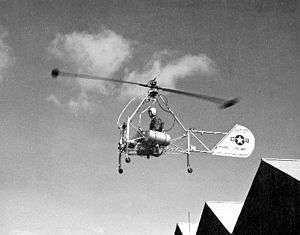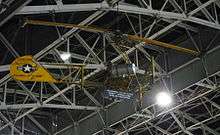McDonnell XH-20 Little Henry
| XH-20 Little Henry | |
|---|---|
 | |
| Role | Experimental ramjet-rotor powered helicopter |
| National origin | United States |
| Manufacturer | McDonnell Aircraft |
| First flight | 29 August 1947 |
| Primary user | United States Air Force |
| Number built | 2 |
The McDonnell XH-20 Little Henry was a 1940s American experimental lightweight helicopter designed and built by McDonnell Aircraft.[1]
Development
The McDonnell Model 38 was a lightweight experimental helicopter sponsored by the United States Army Air Force to test the concept of using small ramjets at the tips of the rotor blades.[1] As a functional helicopter it was of simple open-frame steel-tube construction.[1] Allocated the military designation XH-20 the first of two first flew on the 29 August 1947.[1]
Although the XH-20 flew successfully the ramjets were noisy and burnt a large amount of fuel and plans to build a larger two-seat XH-29 were abandoned.
Variants
Operator
Aircraft on display

- 46-689 the first XH-20 is on display at the National Museum of the United States Air Force
Specifications
Data from [1]
General characteristics
- Crew: 1
- Length: 12 ft 6 in (3.81 m)
- Height: 6 ft 8 in (2.03 m)
- Empty weight: 290 lb (132 kg)
- Powerplant: 2 × McDonnell Ramjets
- Main rotor diameter: 20 ft (6.1 m)
Performance
- Maximum speed: 50 mph (80 km/h; 43 kn)
See also
Related lists
References
- Citations
- 1 2 3 4 5 "XH-20 Little Henry Research Helicopter". Boeing. Archived from the original on 2009-12-17. Retrieved 2009-12-20.
- ↑ Andrade 1979, p. 119
- ↑ Andrade 1979, p. 121
- Bibliography
- Andrade, John (1979). U.S.Military Aircraft Designations and Serials since 1909. Midland Counties Publications. ISBN 0-904597-22-9.
External links
![]()